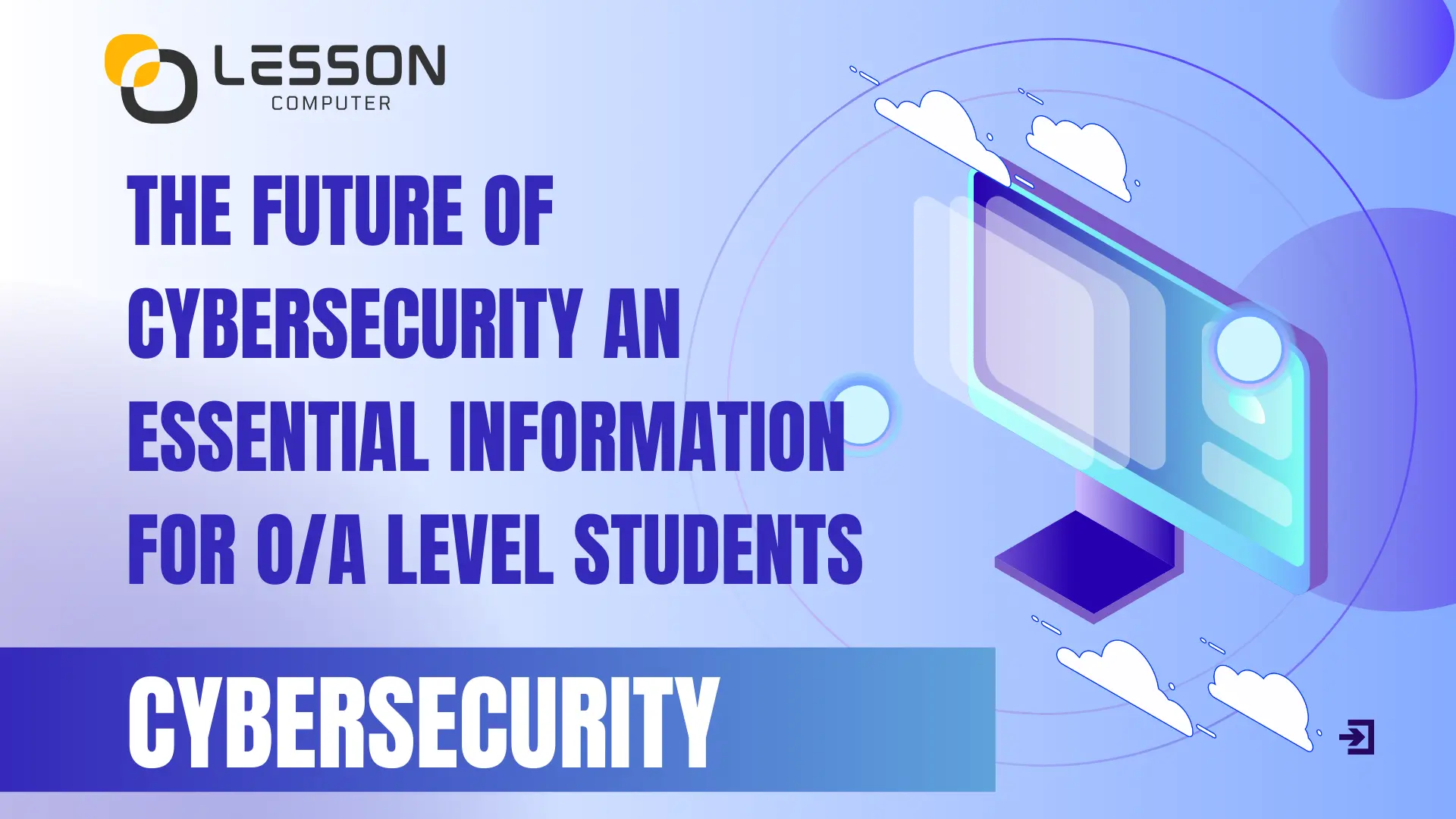
The Future of Cybersecurity An Essential Information For O/A level Students
In today’s rapidly evolving digital landscape, cybersecurity has emerged as an essential concept that transcends the realm of technical experts; it is crucial for everyone, particularly students, to grasp its significance. For those in O/A Levels, who are growing up amidst a barrage of technological advancements, understanding cybersecurity is not just beneficial—it’s imperative. This field presents a unique blend of opportunities and challenges that students will encounter as they navigate their increasingly online worlds.
This blog delves into the dynamic nature of cybersecurity, shedding light on its evolving landscape and the critical concepts that every student should familiarize themselves with. We will explore the various facets of cybersecurity, including the importance of online safety, the potential risks associated with digital interactions, and the protective measures that can be implemented. Furthermore, we will discuss why a robust understanding of cybersecurity will remain essential in the coming years—both for those who wish to pursue it as a career and for all individuals who engage with the online community.
1. What is Cybersecurity and Why Does It Matter?

Cybersecurity encompasses the practices and measures taken to safeguard systems, networks, and data against cyber threats. Essentially, it aims to ensure the safety and security of the digital landscape. With the rapid growth of the internet, the rise of artificial intelligence, and the increasing reliance on cloud computing, the importance of cybersecurity has escalated for individuals, businesses, and governments alike.
For O/A Level students, cybersecurity is more than just a trendy topic; it is an integral aspect of their daily activities. Whether they are engaging with social media or completing assignments online, students continuously interact with various technologies. By acquiring knowledge about cybersecurity, they can better protect themselves as they navigate the complexities of the digital world.
Why Cybersecurity Matters for Students:
- Safeguards personal information from theft or inappropriate use, ensuring that sensitive data remains confidential and secure.
- Shields individuals from the dangers of identity theft, cyberbullying, and various other online threats, promoting a safer digital environment for everyone.
- Fosters an understanding of responsible digital behavior, equipping individuals with the knowledge needed to navigate the online world safely and ethically.
- Creates pathways to a wide range of exciting career opportunities in the growing fields of cybersecurity and digital safety, paving the way for a fulfilling professional journey..
2. The Growing Importance of Cybersecurity in the Digital Era
As technology continues to advance, the landscape of cyber threats evolves as well. The digital transformation across various industries, the growing prevalence of remote work, and the widespread adoption of smart devices have significantly heightened the importance of cybersecurity. It is essential to stay vigilant and proactive in safeguarding against these emerging risks.
Key Trends Driving the Importance of Cybersecurity:
- Increased Connectivity: As the prevalence of Internet of Things (IoT) devices continues to grow, the landscape of smart homes is becoming increasingly intricate. This evolution significantly broadens the potential entry points for cybercriminals, creating a more extensive and vulnerable attack surface that they can exploit.
- Remote Learning and Work: The move to online platforms has significantly increased the vulnerability of both personal and professional data, leaving us more exposed than ever before.
- Sophisticated Cyber Threats: Cybercriminals are increasingly leveraging sophisticated technologies such as artificial intelligence (AI) and machine learning (ML) to identify and exploit vulnerabilities in various systems. These advanced tools enable hackers to automate their attacks, analyze vast amounts of data, and develop adaptive strategies that outpace traditional security measures. As a result, they can efficiently target weaknesses in software, networks, and even human behavior, making it imperative for organizations to enhance their cybersecurity defenses in order to protect sensitive information and maintain operational integrity.
- Data Privacy Concerns: In today’s digital landscape, effectively safeguarding sensitive data has emerged as a critical global priority. This heightened focus arises from a significant rise in incidents of data breaches, which not only compromise personal information but also threaten the integrity and trust that individuals and organizations place in digital systems. As cyber threats continue to evolve, the need for robust protective measures has never been more urgent..
For students, recognizing these trends is essential; it highlights the critical role of cybersecurity and its direct influence on their daily lives. By understanding this connection, they can take proactive steps to safeguard their personal information and navigate the digital landscape with confidence.
3. Types of Cyber Threats Students Should Know
Cyber threats are varied, ranging from simple phishing scams to complex ransomware attacks. Here are some key threats that O/A Level students should be aware of:
1). Phishing:
Fraudulent emails or messages crafted with the intent to deceive users into disclosing sensitive personal information, such as passwords or credit card numbers. These communications often mimic legitimate organizations, using official logos and language to create a sense of authenticity. They may contain urgent messages that prompt the recipient to act quickly, such as clicking on a link or downloading an attachment, which can lead to data breaches or identity theft. The tactics employed can include phishing, spear phishing, or vishing, making it crucial for users to remain vigilant and cautious when interacting with unsolicited correspondence.
2). Malware:
Malicious software, commonly referred to as malware, encompasses various types of harmful programs such as viruses, worms, and spyware. These programs are specifically designed to disrupt normal operations or to unlawfully access and steal sensitive data.
3). Ransomware:
Ransomware is a specific type of malicious software designed to restrict access to a user’s system or files until a ransom is paid to the attacker. Once the malware infects a device, it typically encrypts important data, rendering it inaccessible to the user. The attacker then demands a payment, often in cryptocurrency, in exchange for the decryption key necessary to regain access to the files. Ransomware attacks can have severe consequences, leading to significant financial loss, disruption of operations, and potential data breaches if sensitive information is involved.
4). Social Engineering:
Cybercriminals often employ a range of cunning and deceptive tactics designed to build trust and manipulate individuals into divulging sensitive information. These strategies might include creating a false sense of urgency, impersonating legitimate organizations, or using emotional appeals to elicit sympathy. By carefully crafting their approaches, they aim to exploit vulnerabilities, fostering a connection that ultimately leads to the unauthorized extraction of personal data or financial details.
5). DDoS Attacks:
Distributed Denial of Service (DDoS) attacks are a malicious attempt to disrupt the normal functioning of a targeted server, service, or network by overwhelming it with a flood of internet traffic. In these attacks, numerous compromised computers or devices, often part of a botnet, send a massive volume of requests to the target, significantly exceeding its ability to handle such traffic. As a result, the targeted network can become sluggish, unresponsive, or entirely unavailable to legitimate users. This overwhelming influx of data can disrupt operations, causing downtime and potential financial loss, as well as damaging the reputation of the affected organization.
By understanding these threats in-depth, students gain invaluable knowledge that enhances their ability to detect and dodge various risks, ensuring their safety and well-being.
4. How Cybersecurity is Evolving
Cybersecurity is an ever-evolving field that continually adjusts to emerging threats and advancements in technology. As we look to the future, it is expected that cybersecurity will incorporate more advanced tools and innovative strategies, offering exciting learning opportunities for students interested in this critical area.
Innovations in Cybersecurity:
- Artificial Intelligence (AI): Artificial intelligence is increasingly being employed to identify and mitigate potential threats in real-time. By leveraging advanced algorithms and machine learning techniques, AI systems analyze vast amounts of data from various sources, such as surveillance cameras, social media feeds, and internal security measures. This enables them to detect unusual patterns or behaviors that may indicate a security risk. These systems can respond swiftly, often providing alerts to security personnel or automatically initiating preventive measures to address potential dangers before they escalate.
- Blockchain Security: Blockchain technology is enhancing the security of various systems by establishing immutable records that cannot be altered or tampered with. This decentralized ledger system ensures that once data is recorded, it remains permanent and trustworthy, significantly reducing the risk of fraud and unauthorized access.
- Quantum Cryptography: Quantum computing is anticipated to bring about a dramatic transformation in the field of encryption methods. Unlike traditional computers that use bits to process information in binary (0s and 1s), quantum computers utilize qubits, which can exist in multiple states simultaneously. This unique ability allows quantum computers to perform complex calculations at incredible speeds. As a result, current encryption algorithms, which rely on the mathematical difficulty of problems such as factoring large numbers or calculating discrete logarithms, could become vulnerable to attacks by quantum algorithms like Shor’s algorithm. Consequently, the rise of quantum computing necessitates the development of new cryptographic techniques that can withstand these powerful computational capabilities, leading to the exploration and implementation of post-quantum cryptography to ensure data security in a future dominated by quantum technology..
- Zero-Trust Architecture: This strategy emphasizes a security model where no user or device is automatically considered trustworthy. By implementing this approach, organizations can significantly bolster their security measures, minimizing the risk of unauthorized access and potential breaches. It ensures that every request for access is rigorously verified, creating a more resilient defense against cyber threats.This strategy emphasizes a security model where no user or device is automatically considered trustworthy. By implementing this approach, organizations can significantly bolster their security measures, minimizing the risk of unauthorized access and potential breaches. It ensures that every request for access is rigorously verified, creating a more resilient defense against cyber threats..
For students dreaming of a career in cybersecurity, these innovations open doors to amazing opportunities with cutting-edge technologies.
5. Key Cybersecurity Skills for the Future
To succeed in the dynamic and ever-evolving field of cybersecurity, students must cultivate a specific set of skills that are crucial for both their professional growth and their roles as responsible digital citizens. These essential skills encompass a deep understanding of cybersecurity principles, hands-on experience with various security tools, and the ability to analyze and respond to threats effectively. By mastering these competencies, students not only prepare themselves for a rewarding career in cybersecurity but also empower themselves to navigate the digital landscape safely and ethically, fostering a respectful and secure online environment for everyone.
Essential Skills:
- Technical Proficiency: A comprehensive understanding of programming languages, including their syntax, semantics, and paradigms, is essential for effective software development. This knowledge allows developers to write efficient and maintainable code. Additionally, a solid grasp of computer networks is critical, as it involves studying how data is transmitted across various devices and understanding protocols, network architecture, and security measures that ensure reliable communication. Moreover, familiarity with operating systems is crucial, as they serve as the interface between hardware and software, managing resources, processes, and file systems to facilitate user interactions and system performance. Together, these three domains form the foundation of modern computing and technology.
- Problem-Solving: Examining potential risks and vulnerabilities in various contexts while developing and implementing strategic solutions to mitigate those threats effectively. This process involves thorough research, risk assessment, and the identification of proactive measures to ensure safety and security.
- Ethical Hacking: Gaining the skills to recognize and assess vulnerabilities within various systems is crucial for ensuring their security and integrity. This process involves understanding the different types of vulnerabilities that may exist, as well as the methodologies for identifying and documenting them. By analyzing system architecture, software configurations, and user behaviors, one can effectively spot weaknesses that could be exploited by malicious actors. Familiarity with tools and techniques such as penetration testing, vulnerability scanning, and security audits also plays a key role in systematically uncovering potential risks. Overall, mastering these skills enables individuals to proactively enhance system defenses and mitigate threats effectively.
- Data AnalysisAnalyzing data to identify trends, patterns, and irregularities that may indicate significant insights or potential issues.
- Communication: Providing clear and understandable explanations of intricate security concepts to audiences without a technical background. This involves breaking down sophisticated ideas into simpler terms and using relatable analogies, ensuring that those unfamiliar with the subject matter can grasp the essential elements of security practices and principles.
- O/A Level students have a fantastic opportunity to kickstart their journey towards valuable skills! Dive into online courses, tackle exciting coding challenges, and participate in hands-on cybersecurity workshops. Get ready to unleash your potential and explore the amazing world of technology!
6. Cybersecurity Careers: Opportunities for Students

Cybersecurity presents an extensive array of career opportunities that cater to various skill sets, ranging from highly technical roles focused on system protection to strategic leadership positions that shape organizational security policies. As the landscape of cyber threats becomes increasingly sophisticated and pervasive, the need for skilled cybersecurity professionals is experiencing unparalleled growth. This surge in demand not only underscores the critical importance of safeguarding sensitive information but also positions cybersecurity as a highly lucrative and rewarding career choice for those interested in technology and defense. Whether one is drawn to roles in ethical hacking, incident response, security analysis, or executive-level cybersecurity management, the field offers diverse paths that provide both professional fulfillment and significant financial incentives.
Popular Career Options:
- Cybersecurity Analyst: Overseeing and addressing security incidents effectively and promptly. This involves not only tracking and identifying potential threats but also taking appropriate actions to mitigate risks and safeguard systems.
- Penetration Tester: Conducting thorough assessments of systems to identify potential vulnerabilities and weaknesses that could be exploited by malicious actors. This involves utilizing various testing methodologies and tools to systematically evaluate software, hardware, and network configurations for security flaws, misconfigurations, and other risks.
- Security Architect: Creating robust and secure systems and networks that protect sensitive information and ensure reliable performance..
- Forensic Analyst: Delving into the intricacies of cybercrimes involves meticulously examining digital activities and online behaviors to uncover illicit actions. This process includes gathering and analyzing various forms of evidence, such as electronic communications, transaction records, and metadata, to build a comprehensive understanding of the incidents and identify those responsible.
- Chief Information Security Officer (CISO): Developing and guiding the overarching cybersecurity strategy for an organization. This involves assessing potential vulnerabilities, establishing protective measures, and ensuring a robust response plan to safeguard sensitive data and maintain operational integrity.
The field is vibrant and filled with diverse opportunities, spanning exciting industries such as finance, healthcare, and government. There’s something for everyone, whether you’re drawn to the fast-paced world of finance, the impactful realm of healthcare, or the essential functions of government. The possibilities are endless! The field is vibrant and filled with diverse opportunities, spanning exciting industries such as finance, healthcare, and government. There’s something for everyone, whether you’re drawn to the fast-paced world of finance, the impactful realm of healthcare, or the essential functions of government. The possibilities are endless!
7. Cybersecurity Awareness: Tips for Students
Even if students don’t choose to dive into cybersecurity as a career, grasping the fundamental practices is crucial for everyone in today’s digital age. It’s not just about defense; it’s about empowering ourselves and staying safe online!
Best Practices for Students:
- Create robust and unique passwords for each of your accounts to enhance security and minimize the risk of unauthorized access. Consider using a mix of uppercase and lowercase letters, numbers, and special characters to make your passwords more difficult to guess.
- Take advantage of two-factor authentication (2FA) whenever it is available. This additional layer of security requires not only your password but also a second piece of information, such as a code sent to your phone, making it much harder for someone to gain access to your account without your consent.
- Exercise caution when engaging with online content; carefully consider the links you click on and be vigilant when downloading files. Malicious links or attachments can compromise your device and lead to data breaches or infections.
- Keep your devices and software current by regularly applying updates. Software updates often include patches designed to fix security vulnerabilities, ensuring your systems remain protected against newfound threats.
- Refrain from sharing personal or sensitive information while connected to public Wi-Fi networks. These networks can be less secure and more susceptible to cyberattacks, so it’s wise to use a virtual private network (VPN) or wait until you’re on a secure connection before entering sensitive data.
- Unlocking your digital safety can be as easy as following a few straightforward steps! By taking these simple actions, you can dramatically decrease the risk of falling victim to cyber threats. Stay proactive and keep your online presence secure!
8. The Role of Schools in Cybersecurity Education
Educational institutions are pivotal in shaping a secure digital landscape for future generations. By integrating cybersecurity principles into their teaching frameworks, schools can empower students with essential skills and knowledge. This proactive approach not only enhances students’ understanding of potential online threats but also fosters their ability to navigate the digital world safely and responsibly. By cultivating a culture of awareness and preparedness, schools can ensure that students are not just consumers of technology but also informed guardians of their digital futures.
Ways Schools Can Promote Cybersecurity:
- Workshops: Conducting informative sessions that delve into crucial subjects such as ethical hacking techniques and strategies for robust data protection. These discussions aim to raise awareness and equip participants with the knowledge and skills necessary to navigate and mitigate cybersecurity threats effectively.
- Interactive Learning: Incorporating gamified tools into the educational process can significantly enhance the teaching of cybersecurity concepts. By utilizing interactive and engaging game-like elements, educators can create immersive learning experiences that capture students’ attention and encourage active participation. These tools can include simulations, quizzes, scenarios, and role-playing exercises that mimic real-world cybersecurity challenges.
For example, students might engage in a simulated cyber attack where they must identify vulnerabilities, defend against threats, and respond to incidents within a safe environment. This hands-on approach not only reinforces theoretical knowledge but also develops practical skills that are crucial in the field of cybersecurity. Additionally, gamification can foster collaboration and teamwork, as learners often work together to solve problems and complete challenges.
Ultimately, by incorporating gamified tools into cybersecurity education, instructors can make complex concepts more accessible and enjoyable, preparing students to navigate and protect against digital threats effectively.
- Collaborations: Collaborating with technology companies to develop and implement comprehensive training programs designed to enhance skills and knowledge in the latest industry practices. These partnerships aim to provide hands-on experience, access to cutting-edge tools, and insights from experts in the field, ensuring participants are well-equipped to meet the demands of a rapidly evolving tech landscape.
- Cyber Clubs: Developing initiatives led by students to delve into the fascinating world of cybersecurity. These projects aim to empower students to take charge of their learning, fostering an environment where they can investigate current cybersecurity challenges, collaborate on innovative solutions, and enhance their skills in this critical field.
For O/A Level students, these programs lay a powerful foundation for understanding and pursuing an exciting future in cybersecurity.
9. Global Cybersecurity Challenges and Their Impact on Students
Cybersecurity has emerged as a critical global issue that affects individuals, organizations, and nations alike. The rapid advancement of technology and the increasing reliance on digital platforms amplify the complexities of safeguarding information and systems from malicious attacks. For students, gaining insight into these challenges is essential, as it not only fosters awareness but also highlights the profound impact cybersecurity has on various aspects of society.
By exploring threats such as cyberattacks, data breaches, and identity theft, students can grasp the implications these issues hold for personal privacy, corporate integrity, and national security. Understanding the evolving landscape of cybersecurity enables them to appreciate the necessity of robust security measures and the role that legislation, ethical behavior, and proactive defense strategies play in mitigating risks. This knowledge equips future leaders and professionals with the critical thinking skills needed to navigate the digital world effectively and responsibly.
Major Challenges:
- Cyber Warfare: Nation-states are increasingly focusing their efforts on strategically disrupting or compromising critical infrastructure systems. These vital components, which include everything from power grids and water supplies to transportation networks and communication systems, are essential for the functioning and security of societies. The targeting of such infrastructure poses significant risks, potentially leading to widespread chaos and vulnerability in both civilian and military contexts.
- Global Data Breaches: Disclosing sensitive personal and organizational information to a broad audience, resulting in significant risks to individual privacy and security. This large-scale exposure can involve data such as financial records, private communications, or proprietary business strategies, leading to potential misuse or exploitation by malicious actors.
- AI-Powered Attacks: Cybercriminals are increasingly utilizing advanced artificial intelligence to develop highly sophisticated and targeted threats, making their attacks more effective and harder to detect than ever before.
- Skills Gap: There is a significant and pressing shortage of cybersecurity professionals around the globe, creating a critical gap in the protection of digital assets and information. This lack of skilled experts is impacting organizations’ ability to defend against increasingly sophisticated cyber threats and maintain robust security measures.
Students who recognize these challenges are not only more informed, but they also become key players in crafting innovative solutions for the future. Students who recognize these challenges are not only more informed, but they also become key players in crafting innovative solutions for the future.
10. The Future of Cybersecurity: Why Students Should Care
The future of cybersecurity holds promising prospects, yet it also presents a considerable challenge. As technology evolves at a rapid pace, the demand for highly skilled professionals in this field is anticipated to rise significantly. This growing need underscores the importance of continuous learning and adaptation, as individuals will be required to stay ahead of emerging threats and sophisticated cyber attacks that target sensitive information and critical systems. The landscape of cybersecurity will not only demand technical expertise but also innovative thinking and problem-solving abilities to navigate an increasingly complex digital world.
Why Students Should Care:
- Cybersecurity plays a crucial role in nearly every facet of contemporary existence, influencing everything from the safeguarding of individual privacy to the overarching structures of global security. It encompasses a wide range of practices and technologies designed to protect sensitive information and critical infrastructure, ensuring that personal data remains secure while also contributing to the stability and safety of nations around the world. In an age increasingly dominated by digital interactions, the importance of robust cybersecurity measures cannot be overstated, as they form the backbone of trust and safety in our interconnected society.
- Mastering cybersecurity skills opens the door to exciting, high-demand careers, equipping students for a future where they can safeguard the digital world.
- Practicing responsible digital behavior is essential for fostering a safer online environment for all individuals. By being mindful of our actions, we can reduce the risks associated with cyberbullying, harassment, and misinformation. This includes respecting others’ privacy, thinking critically before sharing information, and promoting positive interactions in digital spaces. Collectively, these efforts contribute to a more secure and supportive online community where everyone can engage without fear of harm or negativity.
- Understanding the future of cybersecurity equips O/A Level students to take proactive measures for their personal protection while also exploring the dynamic opportunities available in this rapidly evolving field.
Conclusion: Empowering the Next Generation of Cyber Defenders
Cybersecurity represents a multifaceted discipline that transcends mere technical proficiency—it’s an essential skill set for successfully navigating today’s complex digital landscape. For O/A Level students, acquiring knowledge in cybersecurity goes beyond simply safeguarding themselves against potential threats; it prepares them for a future in which technology and security are intricately connected and increasingly important.
By delving into the intricacies of cybersecurity, students can evolve into informed digital citizens, equipped to make thoughtful decisions in a technology-driven world. This knowledge opens up a multitude of rewarding career paths, from security analysis and ethical hacking to cybersecurity policy development, allowing them to find their niche in a rapidly growing field.
These students are essential in cultivating a safer online environment for all. Their journey starts with raising awareness about the diverse risks and best practices in cybersecurity, opening the door to endless opportunities for innovation and protection. By embracing the principles of cybersecurity, they not only enhance their own safety but also empower themselves to make significant contributions to society in an age where digital safety is crucial.
Discover more from Lesson Computer
Subscribe to get the latest posts sent to your email.



